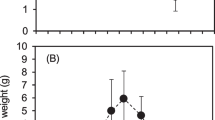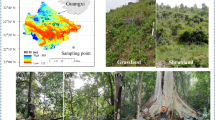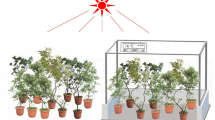Summary
An investigation was carried out into the photosynthetic pathways of the complete bromeliad flora of Trinidad (West Indies). Carbon-isotope ratios (δ13C values) were used to distinguish obligate C3 and crassulacean acid metabolism (CAM) species. Measurements were also carried out on some species in the field to test for day-night changes in leaf titratable acidity.
A wide range of δ13C values was found. The obligate CAM species had values of -10 to -20‰ and the obligate C3 species of -23 to -35‰ CAM was found (a) in the majority of Tillandsia spp. (Tillandsioideae) and (b) in all species of Bromelioideae. The other genera of the Tillandsioideae appeared to be at least predominantly C3. One species, Guzmania monostachia var. monostachia, was identified as a C3-CAM intermediate, and others may well exist in the Trinidad flora. The influence of factors such as source CO2, photosynthetic photon flux density and ambient humidity in determining the δ13C values is discussed.
The taxonomic distribution of C3 and CAM species within the Bromeliaceae is analyzed in terms of the life-forms and ecological types recognized by Pittendrigh (1948). The most xerophytic species (the light-demanding “atmospherics”) all show CAM and are restricted to the drier parts of the island. Most of the species with waterstoring “tanks” have a wide geographic distribution: these include light-demanding C3 plants and less light-demanding CAM plants. The shade-tolerant bromeliads, which show a requirement for high ambient humidity, are all C3 plants. We discuss the phylogenetic origins of CAM and the epiphytic habit in the Bromeliaceae.
Similar content being viewed by others
References
Beard JS (1946) The Natural Vegetation of Trinidad. Oxford Forestry Memoirs, Number 20. Oxford University Press
Bendrat M (1929) Zur Physiologie der organischen Säuren in grünen Pflanzen. VI. Ein Beitrag zur Kenntnis des Säurestoffwechels sukkulenter Pflanzen. Planta 7:508–584
Benzing DH (1980) The Biology of the Bromeliads. Mad River Press Inc., Eureka, California
Benzing DH, Renfrow A (1971a) The significance of photosynthetic efficiency to habitat preference and phylogeny among tillandsioid bromeliads. Bot Gaz 132:19–30
Benzing DH, Renfrow A (1971b) Significance of the patterns of CO2 exchange to the ecology and phylogeny of the Tillandsioideae (Bromeliaceae). Bull Torrey Bot Club 98:322–327
Björkman O (1981) Responses to different quantum flux densities. In: Encyclopedia of Plant Physiology, New Series, Vol 12A, Physiological Plant Ecology I, Responses to the Physical Environment, Lange OL, Nobel PS, Osmond CB, Ziegler H (eds). Springer-Verlag, Berlin Heidelberg New York, pp 57–107
Boardman NK (1977) Comparative photosynthesis of sun and shade plants. Ann Rev Plant Physiol 28:355–377
Coutinho LM (1963) Algumas informações sôbre a ocorrência do “Efeito de De Saussure” em epífitas e erbáceas terrestres da mata pluvial. Bol Fac Filos Ciên Letr USP No. 288, Botânica 20:81–98
Coutinho LM (1969) Novas observações sôbre a ocorrência do “Efeito de De Saussure” e suas relações com a suculência, a temperatura folhear e os movimentos estomáticos. Bol Fac Filos Ciên Letr USP No. 331, Botânica 24:77–102
Craig H (1957) Isotopic standards for carbon and oxygen and correction factors for mass-spectrometric analysis of carbon dioxide. Geochim Cosmochim Acta 12:133–149
Deleens E, Garnier-Dardart J (1977) Carbon isotope composition of biochemical fractions isolated from leaves of Bryophyllum daigremontianum Berger, a plant with crassulacean acid metabolism: some physiological aspects related to CO2 dark fixation. Planta 135:241–248
Farquhar GD, Ball MC, von Caemmerer S, Roksandic Z (1982a) Effect of salinity and humidity on δ13C value of halophytes — evidence for diffusional isotope fractionation determined by the ratio of intercellular/atmospheric partial pressure of CO2 under different environmental conditions. Oecologia (Berlin) 52:121–124
Farquhar GD, O'Leary MH, Berry JA (1982b) On the relationship between carbon isotope discrimination and the intercellular carbon dioxide concentration in leaves. Aust J Plant Physiol 9:121–137
French RP (1973) A guide to the birds of Trinidad and Tobago. Livingston, Wynnewood, Pennsylvania
Kluge M, Lange OL, von Eichmann M, Schmid M (1973) Diurnaler Säurerhythmus bei Tillandsia usneoides: Untersuchungen über den Weg des Kohlenstoffs sowie die Abhängigkeit des CO2-Gaswechsels von Lichtintensität, Temperatur und Wassergehalt der Pflanze. Planta 112:357–372
Kluge M, Ting IP (1978) Crassulacean Acid Metabolism. Analysis of an Ecological Adaptation. Springer-Verlag, Berlin Heidelberg New York
Martin CE, Christensen NL, Strain BR (1981) Seasonal patterns of growth, tissue acid fluctuations, and 14CO2 uptake in the Crassulacean Acid Metabolism epiphyte Tillandsia usneoides L. (Spanish Moss). Oecologia (Berlin) 49:322–328
McWilliams EL (1970) Comparative rates of dark CO2 uptake and acidification in the Bromeliaceae, Orchidaceae, and Euphorbiaceae. Bot Gaz 131:285–290
McWilliams EL (1974) Chromosome number and evolution. In: Flora Neotropica, Monograph No. 14, Part 1, Pitcairnioideae (Bromeliaceae), Smith LB, Downs RJ. Hafner Press, New York, pp 33–40
Medina E (1974) Dark CO2 fixation, habitat preference and evolution within the Bromeliaceae. Evolution 28:677–686
Medina E, Delgado M, Troughton JH, Medina JD (1977) Physiological ecology of CO2 fixation in Bromeliaceae. Flora 166:137–152
Medina E, Minchin P (1980) Stratification of δ13C values in Amazonian rain forests. Oecologia (Berlin) 45:377–378
Medina E, Troughton JH (1974) Dark CO2 fixation and the carbon isotope ratio in Bromeliaceae. Plant Sci Lett 2:357–362
Mez C (1904) Physiologische Bromeliaceen-Studien. I. Die Wasser-Ökonomie der extrem atmosphärischen Tillandsien. Jahrb wiss Botanik 40:157–229
Mooney HA, Troughton JH, Berry JA (1977) Carbon isotope ratio measurements of succulent plants in southern Africa. Oecologia (Berlin) 30: 295–305
Nuernbergk EL (1961) Endogener Rhythmus und CO2-Stoffwechsel bei Pflanzen mit diurnalem Säurerhythmus. Planta 56:28–70
O'Leary MH (1980) Carbon isotope fractionation in plants. Phytochemistry 20:553–567
O'Leary MH, Osmond CB (1980) Diffusional contribution to carbon isotope fractionation during dark CO2 fixation in CAM plants. Plant Physiol 66:931–934
Ortlieb U, Winkler S (1977) Ökologische Differenzierungsmuster in der Evolution der Bromeliaceen. Bot Jahrb Syst 97:586–602
Osmond CB (1978) Crassulacean acid metabolism: a curiosity in context. Ann Rev Plant Physiol 29:379–414
Osmond CB, Ziegler H, Stichler W, Trimborn P (1975) Carbon isotope discrimination in alpine succulent plants supposed to be capable of crassulacean acid metabolism (CAM). Oecologia (Berlin) 18:209–217
Osmond CB, Winter K, Ziegler H (1982) Functional significance of different pathways of CO2 fixation in photosynthesis. In: Encyclopedia of Plant Physiology, New Series, Vol 12B, Physiological Plant Ecology II, Water Relations and Carbon Assimilation, Lange OL, Nobel PS, Osmond CB, Ziegler H (eds). Springer-Verlag, Berlin Heidelberg New York, pp 479–547
Pittendrigh CS (1948) The bromeliad-Anopheles-malaria complex in Trinidad. I—The bromeliad flora. Evolution 2:58–89
Rauh W (1970) Bromelien für Zimmer und Gewächshaus. Band 1, Die Tillandsioideen. Eugen Ulmer, Stuttgart
Raven JA, Beardall J, Griffiths H (1982a) Inorganic C-sources for Lemanea, Cladophora and Ranunculus in a fast-flowing stream: measurements of gas exchange and of carbon isotope ratio and their ecological implications. Oecologia (Berlin) 53:68–78
Raven JA, Griffiths H, Glidewell SM, Preston T (1982b) The mechanism of oxalate biosynthesis in higher plants: investigations with the stable isotopes 18O and 13C. Proc R Soc Lond B 216:87–101
Rundel PW, Rundel JA, Ziegler H, Stichler W (1979) Carbon isotope ratios of central Mexican Crassulaceae in natural and greenhouse environments. Oecologia (Berlin) 38:45–50
Schimper AFW (1888) Die epiphytische Vegetation Amerikas. Bot Mitt Tropen II
Smith LB (1934) Geographical evidence on the lines of evolution in the Bromeliaceae. Bot Jahrb 66:446–468
Smith LB, Downs RJ (1974) Flora Neotropica, Monograph No. 14, Part 1, Pitcairnioideae (Bromeliaceae). Hafner Press, New York
Smith LB, Downs RJ (1977) Flora Neotropica, Monograph No. 14, Part 2, Tillandsioideae (Bromeliaceae). Hafner Press, New York
Smith LB, Downs RJ (1979) Flora Neutropica, Monograph No. 14, Part 3, Bromelioideae (Bromeliaceae). Hafner Press, New York
Smith LB, Pittendrigh CS (1967) Bromeliaceae. In: Flora of Trinidad and Tobago, Vol III, Part II, Epigynae (pars). Ministry of Agriculture, Industry and Commerce, Trinidad and Tobago, pp 35–91
Sugden AM (1981) Aspects of the ecology of vascular epiphytes in two Colombian cloud forests. II. Habitat preferences of Bromeliaceae in the Serranía de Macuira. Selbyana 5:264–273
Teeri J (1982) Photosynthetic variation in the Crassulaceae. In: Crassulacean Acid Metabolism, Ting IP, Gibbs M (eds). American Society of Plant Physiologists, Rockville, Maryland, pp 244–259
Tenhunen JD, Tenhunen LC, Ziegler H, Stichler W, Lange OL (1982) Variation in carbon isotope ratios of Sempervivoideae species from different habitats of Teneriffe in the spring. Oecologia (Berlin) 55:217–224
Tietze M (1906) Physiologische Bromeliaceen-Studien. II. Die Entwicklung der wasseraufnehmenden Bromeliaceen Trichome. Z Naturwiss 78:1–49
Ting IP, Gibbs M (eds) (1982) Crassulacean Acid Metabolism. American Society of Plant Physiologists, Rockville, Maryland
Tomlinson PB (1969) Anatomy of the Monocotyledons (Metcalfe CR, ed), III Commelinales-Zingiberales. Oxford University Press
Troughton JH (1979) δ13C as an indicator of carboxylation reactions. In: Encyclopedia of Plant Physiology, New Series, Vol 6, Photosynthesis II, Photosynthetic Carbon Metabolism and Related Processes, Gibbs M, Latzko E (eds). Springer-Verlag, Berlin Heidelberg New York, pp 140–149
Warburg O (1886) Über die Bedeutung der organischen Säuren für den Lebensprozess der Pflanzen (speziell der sog. Fettpflanzen). Untersuchungen Bot Inst Tübingen 2:53–150
Winter K (1979) δ13C values of some succulent plants from Madagascar. Oecologia (Berlin) 40:103–112
Winter K, Troughton JH (1978) Photosynthetic pathways in plants of coastal and inland habitats of Israel and the Sinai. Flora 167:1–34
Winter K, Wallace BJ, Stocker GC, Roksandic Z (1983) Crassulacean acid metabolism in Australian vascular epiphytes and some related species. Oecologia (Berlin) 57:129–141
Zioegler H, Batanouny KH, Sankhla N, Vyas OP, Stichler W (1981) The photosynthetic pathway types of some desert plants from India, Saudi Arabia, Egypt, and Iraq. Oecologia (Berlin) 48:93–99
Author information
Authors and Affiliations
Rights and permissions
About this article
Cite this article
Griffiths, H., Smith, J.A.C. Photosynthetic pathways in the Bromeliaceae of Trinidad: relations between life-forms, habitat preference and the occurrence of CAM. Oecologia 60, 176–184 (1983). https://doi.org/10.1007/BF00379519
Received:
Issue Date:
DOI: https://doi.org/10.1007/BF00379519




